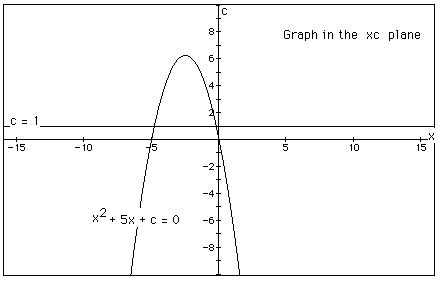
The Department of Mathematics Education
J. Wilson, EMAT 6680

The Department of Mathematics Education
J. Wilson, EMAT 6680
Assignment #3
![]()
and to overlay several graphs of
![]()
for different values of a, b, or c as the other two are held constant. From these graphs discussion of the patterns for the roots of
![]()
can be followed. For example, if we set
![]()
for b = -3, -2, -1, 0, 1, 2, 3, and overlay the graphs, the following picture is obtained.
Now consider the locus of the vertices of the set of parabolas graphed from
![]() .
.
Show that the locus is the parabola
![]()
Generalize.
By substituting several values for b and solving will give the equation ![]() ,
which is the locus of the parabolas.
,
which is the locus of the parabolas.
Consider again the equation
![]()
Now graph this relation in the xb plane. We get the following graph.

If we take any particular value of b, say b = 3, and overlay this equation on the graph we add a line parallel to the x-axis. If it intersects the curve in the xb plane the intersection points correspond to the roots of the original equation for that value of b. We have the following graph.

For each value of b we select, we get a horizontal line. It is clear on a single graph that we get two negative real roots of the original equation when b > 2, one negative real root when b = 2, no real roots for -2 < b < 2, One positive real root when b = -2, and two positive real roots when b < -2.
Consider the case when c = - 1 rather than + 1.

![]()
is considered. If the equation is graphed in the xc plane, it is easy to see that the curve will be a parabola. For each value of c considered, its graph will be a line crossing the parabola in 0, 1, or 2 points -- the intersections being at the roots of the orignal equation at that value of c. In the graph, the graph of c = 1 is shown. The equation
![]()
will have two negative roots -- approximately -0.2 and -4.8.

There is one value of c where the equation will have only 1 real root -- at c = 6.25. For c > 6.25 the equation will have no real roots and for c < 6.25 the equation will have two roots, both negative for 0 < c < 6.25, one negative and one 0 when c = 0 and one negative and one positive when c < 0.